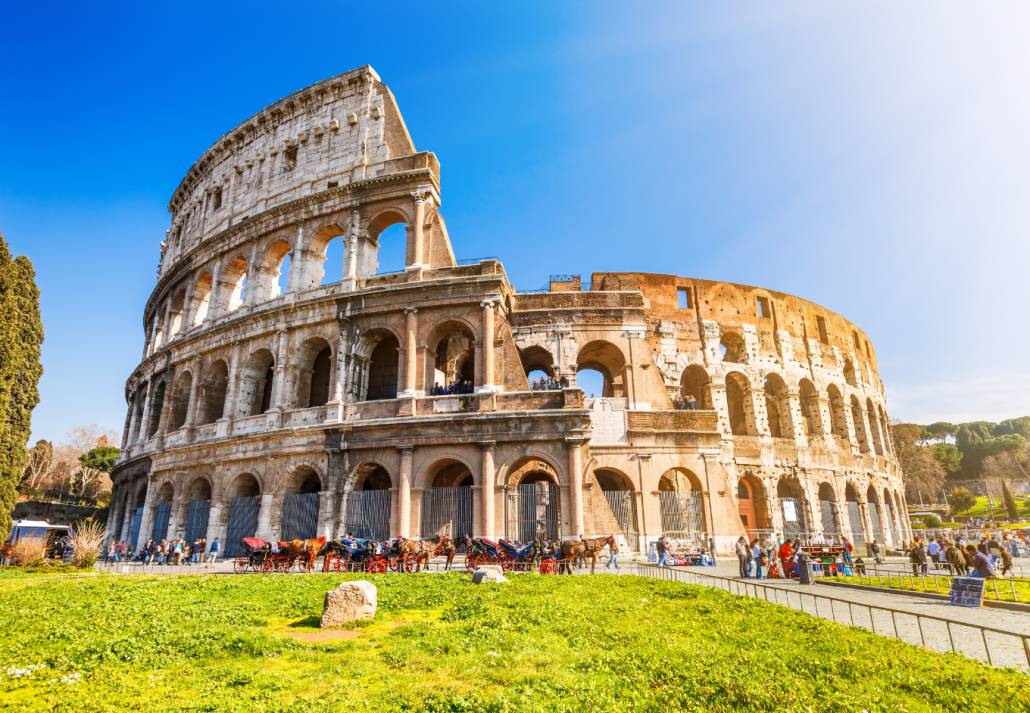Built between C.E. 70 and 72, the Colosseum is a well-known Roman amphitheater that Roman citizens enjoyed at the height of the Roman Empire.
Is there a monument more famous than this one from Italy? Hasn’t anyone heard about this before?
Despite all these years, it remains the largest standing amphitheater globally and the largest ancient amphitheater ever constructed. However, this iconic theater has captivated the hearts and minds of millions of visitors for centuries, drawing them into a journey through time.
Let’s explore this magnificent structure, delving into its rich history, architectural significance, and enduring legacy.
Quick Overview: Exploring the Iconic Colosseum: A Journey through Time in Rome
- The Colosseum in Ancient Times
- The Colosseum in the Present Day
- Naval Battles Amidst the Arena
- The Origin of the Name
- A Modern Wonder of the World
- Free Admission for Spectacles
- FAQ
The Colosseum in Ancient Times

When Emperor Titus inaugurated the arena, it hosted a hundred days of gladiatorial games, with Emperor Commodus performing numerous times. The amphitheater also hosted dramas, reenactments, and public executions, among other events.
Under the motto of “Bread and Circuses,” the Roman Colosseum (formerly known as the Flavian Amphitheatre) welcomed over 50,000 spectators to witness its most magnificent shows during the Roman Empire.
This architectural marvel hosted many events, from gladiator fights and battle recreations to wild animal exhibitions and prisoner executions. For over 500 years, the arena served as a vibrant hub of activity, captivating the Roman people and providing unparalleled entertainment.
Since the sixth century, the amphitheater has been subject to earthquakes, bombs during World War Two, and pillage. Exhibiting a remarkable ability to adapt, it served many years as a warehouse, cathedral, graveyard, and even a palace reserved for aristocrats.
The Colosseum in the Present Day

The amphitheater started to decay with the collapse of the Western Roman Empire. The building was neglected and destroyed by several earthquakes in the fifth century C.E. By the 20th century. Its original structure had been reduced to almost two-thirds. Still, work started in the 1990s to restore it.
Furthermore, Rome’s most popular tourist attractions are the Colosseum and Vatican City. Six million tourists visit the arena annually. On July 7, 2007, it was inducted into the Seven Wonders of the Modern World list.
Practical Information
Location: Piazza del Colosseo, 00184 Roma
Opening hours: Opens at 8:30 am, and the Roman Forum-Palatine area opens at 9:00 am from 1 to 30 March 2024. At 4:00 pm, the last entry is accepted.
Ticket Price: Adults: € 16 (US$ 17.50); European Union members (18–24): € 2 (US$ 2.20); children (under 17) and senior citizens (over 65): free admission
An enthusiastic visitor, Mario says, “Visiting the Colosseum has been a dream of mine for as long as I can remember, and it did not disappoint. From the moment we caught our first glimpse of its iconic facade, we were spellbound. The guided tour was informative and engaging, providing insights into the daily life of ancient Romans. Climbing to the top tiers offered panoramic views of Rome that will stay with me forever. I highly recommend it to everyone, as it was an incredibly memorable experience!”
Did you know that: 4 Interesting Facts
Naval Battles Amidst the Arena

One of the most intriguing chapters in the arena’s history is its transformation into a stage for naval battles. Emperor Titus ordered the arena to flood to stage a recreation of an ancient sea conflict between Syracuse and Athens.
The Origin of the Name

While the arena is renowned for its iconic moniker, its original name, the Flavian Amphitheater, is still significant. The appellation “Colosseum” is believed to have stemmed from its proximity to the Colossus of Nero, a bronze statue that once towered nearby. This association with one of ancient Rome’s most infamous rulers adds another layer of intrigue to the amphitheater’s storied past.
A Modern Wonder of the World

In 2007, the Roman Colosseum was named one of the ‘New Seven Wonders of the World’ in recognition of its unparalleled historical and architectural significance. This esteemed accolade is a testament to the enduring allure and global reverence this iconic structure commands, cementing its status as a cultural icon of unparalleled magnitude.
Free Admission for Spectacles

Contrary to popular belief, tickets to the grandest spectacles held in the arena were often distributed free of charge. The emperors usually paid for them to maintain a positive public image.
FAQ
What is the Rome Colosseum famous for?
Large-scale performances like gladiatorial matches take place at Rome, Italy’s Colosseum.
What is the best time to visit the amphitheater?
The best time to visit the amphitheater is between November and February for smaller crowds and pleasant weather.
What is inside the amphitheater?
The Emperor’s Box, the Gladiator’s Gate, the Arena, the Hypogeums, and the three levels, each of which has a distinct function, are some of the amenities of the amphitheater.
Which are the top attractions in Rome?
The following are the top attractions in Rome:
Vatican City
Trevi Fountain
Spanish Steps
CuddlyNest provides all accommodations to all travelers at the best price. Find unlimited travel inspiration on our blogs and social media channels Facebook, Instagram, and Pinterest.
You May Also Like:




